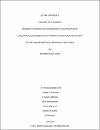Barriers to medication adherence in patients with uncontrolled diabetes in a primary healthcare setting in Qatar: a mixed method triangulation study
| Advisor | Awaisu, Ahmed |
| Advisor | Ibrahim, Mohamed Izham Mohamed |
| Advisor | Kheir, Ahmed Nadir Mohamed |
| Author | Jaam, Myriam Jihad |
| Available date | 2017-11-21T09:44:48Z |
| Publication Date | 2017-06 |
| Abstract | Background: In Qatar, 86% of patients with diabetes are uncontrolled. Given that nonadherence to oral drug therapy and psychological insulin resistance are a common phenomenon, one could postulate that patients may not be taking their medications as prescribed. Therefore, the primary aim of this study was to explore the barriers to medication adherence among patients with uncontrolled diabetes in a primary healthcare setting from the perspectives of the patients and their healthcare providers. Methodology: This study was divided into two phases: patients’ perspective using a mixed-method approach, and healthcare providers’ perspective on the issue using qualitative approach. Patients with uncontrolled diabetes responded to a questionnaire followed by one-to-one in-depth interviews. On the other hand, healthcare providers directly involved in the care of patients with diabetes participated in semi-structured one-to-one interviews. Descriptive and inferential analyses were used for quantitative data, while thematic analysis was used for qualitative data. Finally, data from the two phases were triangulated in interpretation. Results: Overall, 74% of the sample was nonadherent to diabetes medications. The quantitative results indicated that sociodemographic characteristics did not significantly influence medication adherence, except living with family. The majority of pre-determined barriers to medication adherence were reported by nonadherent patients and the most commonly reported barrier was forgetfulness. In addition, significantly higher levels of nonadherence were found among patients who were younger than 65 years and those who were illiterate. Qualitative data revealed five different themes from both patients’ and healthcare providers’ perspectives: (1) patient-related aspects, such as patient’s characteristics, perceptions, attitude and knowledge; (2) patient-provider interaction, which involved communication and interaction time; (3) appointment system and follow up, which was highly varied among patients despite their similar needs; (4) influence of other individuals including family support and social stigma and; (5) traveling and the use of traditional medicine by the patient in home country in an effort to cure the disease. Conclusion: Despite the different perspectives related to medication nonadherence, similar themes emerged from patients and their respective healthcare providers. The identified barriers warrant concerted efforts and series of interventions which should be initiated in a step-wise approach in order to improve medication adherence and overall healthcare outcomes. |
| Language | en |
| Subject | Barriers Diabetes Medication Adherence Qatar Behavioral sciences Health care management Social research |
| Type | Master Thesis |
| Department | Pharmacy |
Files in this item
This item appears in the following Collection(s)
-
Master in Pharmacy [65 items ]


